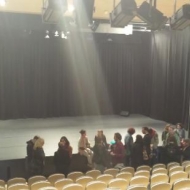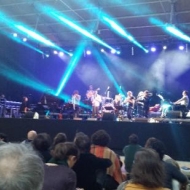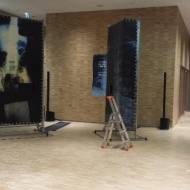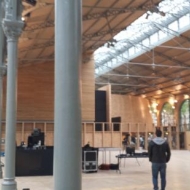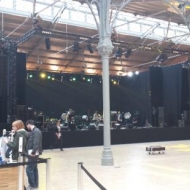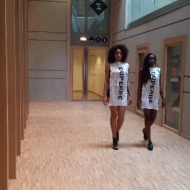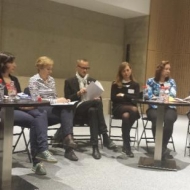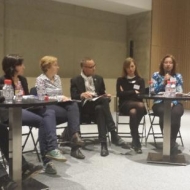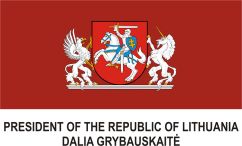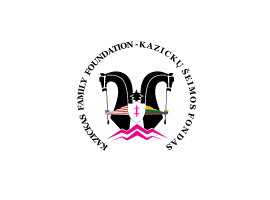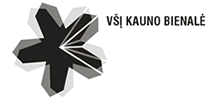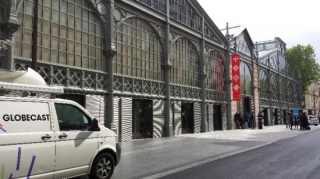 From 24th to 28th April together with my colleague Ana Čižauskienė we participated in an international seminar “Young Creation Companionship” held in Paris. The meeting place was quite extraordinary: artists and cultural sector workers (event producers and artist managers) from eight European countries (France, Germany, Hungary, Croatia, Sweden, Lithuania, Spain and Greece) were invited to the opening of a brand new cultural centre Le Carreau du Temple, which has received endless publicity. The French certainly realise what public spaces are and should be as well as their, as community members, right to them: there were queues throughout the whole weekend with people hoping to get a glimpse inside the new cultural centre. The new multifunctional building, which will be administered by Mezzanine Spectacles organisation, has more than 6,000 square meters of space with theatre and dance studios as well as a sports hall, a recording studio, spaces for workshops, cafes, a concert hall and a black box for theatre productions. The institution is partly supported by the municipality of the city of Paris and partly by projects and leasing of premises for concerts and theatre events. This model of partial support has become commonplace in most European cultural institutions. Since it’s opening in May 2014 Le Carreau du Temple will exist as an incubator for interdisciplinary initiatives by young European artists as well as a platform for international projects.
From 24th to 28th April together with my colleague Ana Čižauskienė we participated in an international seminar “Young Creation Companionship” held in Paris. The meeting place was quite extraordinary: artists and cultural sector workers (event producers and artist managers) from eight European countries (France, Germany, Hungary, Croatia, Sweden, Lithuania, Spain and Greece) were invited to the opening of a brand new cultural centre Le Carreau du Temple, which has received endless publicity. The French certainly realise what public spaces are and should be as well as their, as community members, right to them: there were queues throughout the whole weekend with people hoping to get a glimpse inside the new cultural centre. The new multifunctional building, which will be administered by Mezzanine Spectacles organisation, has more than 6,000 square meters of space with theatre and dance studios as well as a sports hall, a recording studio, spaces for workshops, cafes, a concert hall and a black box for theatre productions. The institution is partly supported by the municipality of the city of Paris and partly by projects and leasing of premises for concerts and theatre events. This model of partial support has become commonplace in most European cultural institutions. Since it’s opening in May 2014 Le Carreau du Temple will exist as an incubator for interdisciplinary initiatives by young European artists as well as a platform for international projects.
Le Carreau du Temple team presented their vision, which they associate with the concept of companionship and developmental activities. Various European cultural entrepreneurs were thus invited to reflect upon this phenomenon. For me the concept had already raised questions even before attending the meeting in Paris. The French organisers invited us as the creatives from Kaunas Biennial intentionally: they have heard presentations on the biennial at other European conferences and thus linked our activities to companionship. We, on the other hand, before the visit whilst reading the seminar programme, where we were included as speakers, considered that perhaps the concept is synonymous with partnership. However, we also had doubts about such an assumption. Already on the first day of the visit we understood the essential characteristics of companionship (the concept and associated activity are fairly widespread in France). Companionship is assistance directed towards young emerging artists, but not merely in the financial sense. It is more than that – it is the artist’s practical introduction into the arts field or arts market with consulting assistance, providing accommodation and spaces to work and help in finding partners. However, the essence of companionship, as was evident from the discussions at the seminar, was not to create greenhouse conditions for emerging artists, but rather assist them in clarifying various stages of artistic conception; show what processes are necessary for successful implementation of the project; when, why and how target groups should be assessed towards whom the artistic production is orientated; how to formulate aims and objectives of the project; what funds should be approached for financial support; how to manage time and resources; in other words – how to realise an idea. An essential role in the creative process is that of an art producer, or in today’s terms, companion. Collaboration since the birth of an idea through to implementation / creation of a product and successful dissemination coherently decide the artist’s and artist manager’s / producer’s distinctive roles as well as mutual (not one-sided, as it often seems to young artists) dependance by strengthening a practice model based on mutual obligations. And while the artist’s and his/her manager’s relationship in the western countries are quite clearly defined (usually the artist has a manager and in France up until the recent crisis it was common practice for one manager to work with only one artist) tensions in project teams arise because artists have low perceptions and are not willing to address the stages in the creation of a product, the mechanisms influencing its introduction to the market and other technical issues, without which it is impossible to run a successful project. Therefore, cultural agents from the “companionship” programme hope to increase openness between the two sides and to involve the artists in all stages of project implementation.
During the seminar it became clear that some of the participants from other countries do not have an equivalent term for “companionship” in their language. It’s not only unheard of or not used by the Lithuanians, but also by Hungarians and Croatians. There are also a number of cultural political differences between these countries. For example, in France there are 600 organisations receiving grants to support companionship led projects for emerging artists at the moment. There are many cases in Lithuania (often in Kaunas Biennial too) when the artists participating in the project receive support in order to start their career – they are given the space to work, display their works or hold performaces, and care is taken of the information dissemination. However, such activities are specific to the project, which by one way or another the artist was involved with, that is lead by objectives and resources. Young artists with new ideas in Lithuania are almost going nowhere. I say almost, because there are some initiatives emerging in Lithuania as well that are intuitive and responsive to the needs. At the seminar in Paris it was a real pleasure to meet with colleagues from Vilnius, the organistion Artscape – Radvilė Šumilė (producer) ir Elvita Brazdylytė (young set designer). Artscape is an organisation that manages young artists by promoting and supporting contemporary art creators in the fields of information resources, professional development and implementation of artistic ideas and initiatives. Artscape team consults, curates and coordinates the developmental processes of artistic projects. In many aspects the aims and philosophy of our respective organisations are identical and we hope to find a number of points of contact by collaborating in Lithuania. At the seminar we also met a number of creatives from other foreign countries. For example, Croatian music production agency Lab852. Two young women – Karmen Krasić Kožul and Danijela O Tonković, work in the small company, similar in size to Kaunas Biennial now. Their work includes managing a number of young musicians, organising an international alternative music festival, expanding national and international partnership connections by employing a number of people for project realisation (and after the project dismissing them). Both our teams, Lithuanian and Croatian, felt a mutual “understanding” / “same wavelength” moment due to a very similar cultural political and the countries economic situation, and more importantly – the proximity of philosophy and objectives valued by both organisations. We have a preliminary agreement with Lab852 team to collaborate at the 10th Kaunas Biennial in creating a unique visual arts and music / sound projects, which will be presented in both countries.
From the reports delivered at the seminar it has become clear that projects, which are organised in Lithuania, Croatia or Hungary, are normally carried out by two or three people, whereas in France, it would seem, there is a team of 14 people. I have noted this particular observation as at international meetings it is always interesting not only to listen to speeches, discuss various themes or new global, or even “European” terms and concepts. It is even more interesting to observe the differences between the old (rich) European countries and the European Union newcomers in ways of thinking and acting in the cultural sector. From indirect experiences and impressions the most obvious to me is the realisation that the difference is not [only] between the funding grants for cultural projects, but also the need for cultural events from the view point of the public. In France to go to concerts, exhibitions, museums is an everyday activity, such as drinking water or eating bread. Well, more precisely – for a good brasserie or chocolaterie you have to stand in the queue for 20 to 30 minutes, but for a good exhibition you might need to queue for up to 2 hours. Even at the best museums you pass a number of kindergarden or primary school groups, and these toddlers, it is obvious, feel like they are in their comfort zone and not in a strange or suppressed environment.
To summarise the discussion themes and reflections on indirect impact held at this invaluable meeting I will try to detail the main aspects of “companionship” (a week ago a term I could not fully grasp):
- Companionship is a mutual process between an artist and a producer / curator of the movement towards a single objective; artists as well as emerging cultural operators are needed for a companionship;
- Companionship enables the realisation of young ideas, provides the artist with long-term tools and skills for its implementation;
- An important aspect of companionship is the activities, which are orientated towards a target group and a specific result that generates added value (cultural, experiential, financial);
- If (and it is so) companionship is the assistance of young creatives to develop their career then in turn they should think about creative returns – the educational aspect of their project, the inclusion of new audiences into the cultural experience and the positive image of the impact of culture.
Virginija Vitkienė


